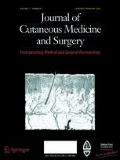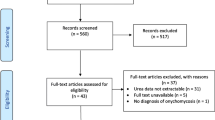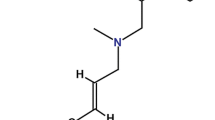Abstract
Background
Antifungal agents are beneficial in the treatment of onychomycosis in the general population, as well as in children, the elderly, and immunocompromised individuals. Special patient populations can be more difficult to treat due to such factors as drug interactions with concomitant medications, adverse events, and poor compliance. In addition, there is limited information about the use of antifungal agents in special populations, e.g., children.
Objective
The pros and cons of oral and topical antifungal agents are discussed, with focus on special patient populations.
Methods
We searched MedLine (1966 to April 2003) for clinical studies evaluating the efficacy of oral and topical antifungal agents to treat onychomycosis. The key words used in conjunction with “onychomycosis” include: “terbinafine,” “itraconazole,” “fluconazole,” “amorolfine nail lacquer,” “ciclopirox nail lacquer,” “HIV,” “transplant patients,” “diabetes,” “children,” and “elderly.” Studies were excluded if published in a language other than English.
Results
Studies have shown that antifungal agents can be of benefit in treating the elderly, children, and immunocompromised individuals (e.g., transplant patients, Down’s patients, HIV patients, and diabetics) with onychomycosis.
Conclusion
The treatment modality of onychomycosis in special patient populations should take into account the clinical presentation of the onychomycosis, the causative organism, patient and physician preference, the concomitant medications that the patient is on, and the potential for adverse events for that patient if antifungal therapy is undertaken.
Sommaire
Antécédents
Les avantages des antifongiques dans le traitement de l’onychomycose sont prouvés chez la population en général, mais surtout dans le cas des enfants, des aînés et des personnes immunocompromises. Le traitement des groupes de patients présentant des cas particuliers peut s’avérer plus difficile en raison de facteurs tels que l’interaction des médicaments, les événements indésirables et le manque de conformité au traitement. De plus, les données sur l’utilisation des antifongiques par des groupes particuliers, tels que les enfants, sont limitées.
Objectif
Les avantages et les inconvénients des antifongiques topiques et oraux seront discutés. Une attention particulière sera prêtée à leur usage par les groupes particuliers.
Méthode
Nous avons effectué des recherches dans MedLine (de 1966 jusqu’en avril 2003) sur les études cliniques qui évaluent l’efficacité des antifongiques oraux et topiques dans le traitement des onychomycoses. Les termes clés utilisés en cooccurrence avec «onychomycosis» étaient:«terbinafine», «itraconazole», «fluconazole», «amorolfine nail lacquer», «ciclopirox nail lacquer», «HIV», «transplant patients», «diabetes», «children» et «elderly». Les études publiées dans une langue autre que l’anglais étaient exclues.
Résultats
Les études ont montré l’avantage des antifongiques dans le traitement des aînés, des enfants et des personnes immunocompromises (p. ex., les patients ayant reçu une transplantation, les patients atteints de trisomie 21, les patients atteint du VIH et les diabétiques) présentant des onychomycoses.
Conclusion
Avant d’entamer un traitement antifongique des onychomycoses chez les groupes de patients particuliers, il faut tenir compte de la présentation clinique de l’onychomycose, de l’organisme causal, de la préférence du patient et du médecin traitant, des médicaments pris en même temps et de la possibilité d’événements indésirables.
Similar content being viewed by others
References
AK Gupta P Taborda V Taborda et al. (2000) ArticleTitleEpidemiology and prevalence of onychomycosis in HIV-positive individuals. Int J Dermatol 39 746–753 Occurrence Handle10.1046/j.1365-4362.2000.00012.x Occurrence Handle1:STN:280:DC%2BD3MzgtlSitw%3D%3D Occurrence Handle11095193
AK Gupta N Konnikov P MacDonald et al. (1998) ArticleTitlePrevalence and epidemiology of toenail onychomycosis in diabetic subjects: a multicentre survey. Br J Dermatol 139 665–671 Occurrence Handle10.1046/j.1365-2133.1998.02464.x Occurrence Handle1:STN:280:DyaK1M7htFejtQ%3D%3D Occurrence Handle9892911
AK Gupta S Humke (2000) ArticleTitleThe prevalence and management of onychomycosis in diabetic patients. Eur J Dermatol 10 379–384 Occurrence Handle1:STN:280:DC%2BD3cvntVykuw%3D%3D Occurrence Handle10882947
AK Gupta MA Gupta RC Summerbell et al. (2000) ArticleTitleThe epidemiology of onychomycosis: possible role of smoking and peripheral arterial disease. J Eur Acad Dermatol Venereol 14 466–469 Occurrence Handle10.1046/j.1468-3083.2000.00124.x Occurrence Handle1:STN:280:DC%2BD3MzptVCqsw%3D%3D Occurrence Handle11444267
AK Gupta HC Jain CW Lynde et al. (1997) ArticleTitlePrevalence and epidemiology of unsuspected onychomycosis in patients visiting dermatologists’ offices in Ontario, Canada—a multicenter survey of 2001 patients. Int J Dermatol 36 783–787 Occurrence Handle10.1046/j.1365-4362.1997.00349.x Occurrence Handle1:STN:280:DyaK1c%2FjvFKhtQ%3D%3D Occurrence Handle9372358
AK Gupta CW Lynde HC Jain et al. (1997) ArticleTitleA higher prevalence of onychomycosis in psoriatics compared with non-psoriatics: a multicentre study. Br J Dermatol 136 786–789 Occurrence Handle10.1046/j.1365-2133.1997.6771624.x Occurrence Handle1:STN:280:ByiA2cblvF0%3D Occurrence Handle9205520
LE. Millikan (2001) ArticleTitleRole of oral antifungal agents for the treatment of superficial fungal infections in immunocompromised patients. Cutis 68 6–14 Occurrence Handle1:STN:280:DC%2BD3MvlsVWmsA%3D%3D Occurrence Handle11499333
AK Gupta RK Scher P Doncker ParticleDe (1997) ArticleTitleCurrent management of onychomycosis. An overview. Dermatol Clin 15 121–135 Occurrence Handle1:CAS:528:DyaK2sXotlWhuw%3D%3D
AK Gupta NH Shear (1999) ArticleTitleThe new oral antifungal agents for onychomycosis of the toenails. J Eur Acad Dermatol Venereol 13 1–13 Occurrence Handle10.1016/S0926-9959(99)00025-2 Occurrence Handle1:STN:280:DC%2BD3c%2FivFemtg%3D%3D Occurrence Handle10565624
AK Gupta NH Shear (1999) ArticleTitleSafety review of the oral antifungal agents used to treat superficial mycoses. Int J Dermatol 38 IssueIDSuppl 2 40–52 Occurrence Handle10.1046/j.1365-4362.1999.00014.x Occurrence Handle10515528
AK Gupta NH Shear (2000) ArticleTitleA risk-benefit assessment of the newer oral antifungal agents used to treat onychomycosis. Drug Saf 22 33–52
R Jaffe (1998) ArticleTitleOnychomycosis: recognition, diagnosis, and management. Arch Fam Med 7 587–592 Occurrence Handle10.1001/archfami.7.6.587 Occurrence Handle1:STN:280:DyaK1M%2FjslGqug%3D%3D Occurrence Handle9821836
AK Gupta JQ Rosso ParticleDel (2000) ArticleTitleAn evaluation of intermittent therapies used to treat onychomycosis and other dermatomycoses with the oral antifungal agents. Int J Dermatol 39 401–411 Occurrence Handle10.1046/j.1365-4362.2000.00964.x Occurrence Handle1:STN:280:DC%2BD3M7gtlGmtw%3D%3D Occurrence Handle10944084
Sporanox® (Itraconazole) capsules prescribing information. Janssen Pharmaceutica Products, L.P. 2001. http://www.sporanox.com/prescribing.jsp.
Lamisil® (terbinafine hydrochloride tablets) prescibing information. Novartis Pharmaceuticals Corporation. 2001. http://www.lamisil.com/pi.jsp?checked = y.
Diflucan® prescribing information. Pfizer. 1998. http://www.diflucan.com/pi.html.
V Goeteyn JM Naeyaert J Lambert et al. (2000) ArticleTitleIs systemic autoimmune disease a risk factor for terbinafine-induced erythema multiforme? Br J Dermatol 142 578–579 Occurrence Handle10.1046/j.1365-2133.2000.03391.x Occurrence Handle1:STN:280:DC%2BD3c3jsVGhsQ%3D%3D Occurrence Handle10777271
M Hall C Monka P Krupp et al. (1997) ArticleTitleSafety of oral terbinafine: results of a post marketing surveillance study in 25,884 patients. Arch Dermatol 133 1213–1219 Occurrence Handle10.1001/archderm.133.10.1213 Occurrence Handle1:CAS:528:DyaK2sXntVGksbw%3D Occurrence Handle9382559
MO Lovell KV Speeg RD Havranek et al. (2003) ArticleTitleHistologic changes resembling acute rejection in a liver transplant patient treated with terbinafine. Hum Pathol 34 187–189 Occurrence Handle10.1053/hupa.2003.16 Occurrence Handle12612888
PenlacTM nail lacquer (ciclopirox) topical solution, 8% prescribing information. Dermik Laboratories Inc. 2000. http://www.dermik.com/prod/penlac/pi.html.
C Seebacher K-H Nietsch HM Ulbricht (2001) ArticleTitleA multicenter, open-label study of the efficacy and safety of cicloprox nail lacquer solution 8% for the treatment of onychomycosis in patients with diabetes. Cutis 68 IssueIDSuppl 2 17–22 Occurrence Handle1:STN:280:DC%2BD3MrmsVKntg%3D%3D Occurrence Handle11665724
AK Gupta (2000) ArticleTitleOnychomycosis in the elderly. Drugs Aging 16 397–407
AK Gupta (2000) ArticleTitlePharmacoeconomic analysis of ciclopirox nail lacquer solution 8% and the new oral antifungal agents used to treat dermatophyte toe onychomycosis in the United States. J Am Acad Dermatol 43 S81–S95 Occurrence Handle10.1067/mjd.2000.109069 Occurrence Handle1:STN:280:DC%2BD3crgt1Kqtg%3D%3D
AK Gupta G Sibbald CW Lynde et al. (1997) ArticleTitleOnychomycosis in children: prevalence and treatment strategies. J Am Acad Dermatol 36 395–402 Occurrence Handle1:STN:280:ByiB38njtl0%3D Occurrence Handle9091470
AK Gupta HC Jain CW Lynde et al. (2000) ArticleTitlePrevalence and epidemiology of onychomycosis in patients visiting physicians’ offices: a multicenter Canadian survey of 15,000 patients. J Am Acad Dermatol 43 244–248 Occurrence Handle10.1067/mjd.2000.104794 Occurrence Handle1:STN:280:DC%2BD3cvivVKjug%3D%3D Occurrence Handle10906646
AK Gupta N Konnikov CW Lynde (2001) ArticleTitleSingle-blind, randomized, prospective study on terbinafine and itraconazole for treatment of dermatophyte toenail onychomycosis in the elderly. J Am Acad Dermatol 44 479–484 Occurrence Handle10.1067/mjd.2001.110874 Occurrence Handle1:STN:280:DC%2BD3M7pslSgug%3D%3D Occurrence Handle11209118
EB Smith LF Stein DP Fivenson et al. (2000) ArticleTitleClinical trial: the safety of terbinafine in patients over the age of 60 years: a multicenter trial in onychomycosis of the feet. Int J Dermatol 39 861–864 Occurrence Handle10.1046/j.1365-4362.2000.00087-2.x Occurrence Handle1:STN:280:DC%2BD3M%2FptlWjtw%3D%3D Occurrence Handle11123452
AK Gupta AR Skinner R Baran (2003) ArticleTitleOnychomycosis in children: an overview. J Drugs Dermatol 2 31–34
P Huang AS Paller (2000) ArticleTitleItraconazole pulse therapy for dermatophyte onychomycosis in children. Arch Pediatr Adolesc Med 154 614–618 Occurrence Handle1:STN:280:DC%2BD3czgs1Krtg%3D%3D Occurrence Handle10850511
AK Gupta S Nolting Y Prost Particlede et al. (1999) ArticleTitleThe use of itraconazole to treat cutaneous fungal infections in children. Dermatology 199 1–5 Occurrence Handle10.1159/000018256
A Bonifaz G Ibarra (2000) ArticleTitleOnychomycosis in children: treatment with bifonazole-urea. Pediatr Dermatol 17 310–314 Occurrence Handle10.1046/j.1525-1470.2000.01761.x Occurrence Handle1:STN:280:DC%2BD3cvktlOjtw%3D%3D Occurrence Handle10990584
V Goulden MJD Goodfield (1995) ArticleTitleTreatment of childhood dermatophyte infections with oral terbinafine. Pediatr Dermatol 12 53–54 Occurrence Handle1:STN:280:ByqA3M3ksFE%3D Occurrence Handle7792222
PJ Velthuis M Nijenhuis (1995) ArticleTitleTreatment of onychomycosis with terbinafine in patients with Down’s syndrome. Br J Dermatol 133 144–146 Occurrence Handle1:STN:280:ByqA1MbisVY%3D
KH Lee YS Kim MS Kim et al. (1996) ArticleTitleStudy of the efficacy and tolerability of oral terbinafine in the treatment of onychomycosis in renal transplant patients. Transplant Proc 28 1488–1489 Occurrence Handle1:CAS:528:DyaK28XktlGksrw%3D Occurrence Handle8658754
GT Nahass M Sisto (1993) ArticleTitleOnychomycosis: successful treatment with once-weekly fluconazole. Dermatology 186 59–61 Occurrence Handle1:STN:280:ByyC28bgtVE%3D Occurrence Handle8435519
R Aly T Berger (1996) ArticleTitleCommon superficial fungal infections in patients with AIDS. Clin Infect Dis 22 IssueIDSuppl 2 S128–S132 Occurrence Handle8722840
F Rongioletti A Persi S Tripodi et al. (1994) ArticleTitleProximal white subungual onychomycosis: a sign of immunodeficiency. J Am Acad Dermatol 30 129–130 Occurrence Handle1:STN:280:ByuC3czks10%3D Occurrence Handle8277014
MA Conant (1994) ArticleTitleThe AIDS epidemic. J Am Acad Dermatol 31 S47–S50 Occurrence Handle1:STN:280:ByuA2MfisVw%3D Occurrence Handle7915731
B Cribier ML Mena D Rey et al. (1998) ArticleTitleNail changes in patients infected with human immunodeficiency virus. A prospective controlled study. Arch Dermatol 134 1216–1220 Occurrence Handle10.1001/archderm.134.10.1216 Occurrence Handle1:STN:280:DyaK1M%2FhvVCrtg%3D%3D Occurrence Handle9801676
CA Elmets (1994) ArticleTitleManagement of common superficial fungal infections in patients with AIDS. J Am Acad Dermatol 31 S60–S63 Occurrence Handle1:STN:280:ByuA2MfisFY%3D Occurrence Handle8077510
P Herranz J Garcia R Lucas ParticleDe et al. (1997) ArticleTitleToenail onychomycosis in patients with acquired immune deficiency syndrome: treatment with terbinafme. Br J Dermatol 137 577–580 Occurrence Handle1:STN:280:DyaK1c%2Flt1SgtA%3D%3D Occurrence Handle9390334
C Pena–Penabad J Garcia–Silva M Almagro et al. (2001) ArticleTitleSuperficial white onychomycosis in a 3-year-old human immunodeficiency virus-infected child. J Eur Acad Dermatol Venereol 15 51–53 Occurrence Handle10.1046/j.1468-3083.2001.00182.x Occurrence Handle1:STN:280:DC%2BD38%2FitFWnuw%3D%3D
P Rich (2000) ArticleTitleOnychomycosis and tinea pedis in patients with diabetes. J Am Acad Dermatol 43 S130–S134 Occurrence Handle10.1067/mjd.2000.110376 Occurrence Handle1:STN:280:DC%2BD3M7pvFSjuw%3D%3D Occurrence Handle11044289
LA Levy (1997) ArticleTitleEpidemiology of onychomycosis in special-risk populations. J Am Podiatr Med Assoc 87 546–550 Occurrence Handle1:STN:280:DyaK1c%2Fos12qtg%3D%3D Occurrence Handle9425802
JJ Anarella C Toth JA DeBello (2001) ArticleTitlePreventing complications in the diabetic patient with toenail onychomycosis. J Am Podiatr Med Assoc 91 325–328 Occurrence Handle1:STN:280:DC%2BD3MzlvFentQ%3D%3D Occurrence Handle11420354
DA Albreski EG Gross (1999) ArticleTitleThe safety of itraconazole in the diabetic population. J Am Podiatr Med Assoc 89 339–345 Occurrence Handle1:STN:280:DyaK1Mzlt1Ogug%3D%3D Occurrence Handle10423939
J Verspeelt G Marynissen AK Gupta et al. (1999) ArticleTitleSafety of itraconazole in diabetic patients. Dermatology 198 382–384 Occurrence Handle10.1159/000018152 Occurrence Handle1:CAS:528:DyaK1MXlsFSitb8%3D Occurrence Handle10449937
B Farkas C Paul A Dobozy et al. (2002) ArticleTitleTerbinafine (Lamisil) treatment of toenail onychomycosis in patients with insulin-dependent and non-insulin-dependent diabetes mellitus: a multicentre trial. Br J Dermatol 146 254–260 Occurrence Handle10.1046/j.1365-2133.2002.04606.x Occurrence Handle1:CAS:528:DC%2BD38XjtVGqurs%3D Occurrence Handle11903236
InstitutionalAuthorNameLamisil® (terbinafine hydrochloride tablets) product information. Novartis Pharmaceuticals (2003) Physicians’ Desk Reference, 57. Thomson PDR Montvale, NJ 2282–2283
InstitutionalAuthorNameLamisil.® Novartis Pharmaceuticals Compendium of Pharmaceuticals and Speicalties (2003) The Canadian Drug Reference for Health Professionals. Canadian Phamacists Association Ottawa, ON 862–864
InstitutionalAuthorNameSporanox® (Itraconazole) capsules product information (2003) Janssen Pharmaceutica Products, L.P. Physicians’ Desk Reference Thomson PDR Montvale, NJ 1790–1794
InstitutionalAuthorNameSporanox® capsules. Janssen-Ortho Compendium of Pharmaceuticals and Specialties (2003) The Canadian Drug Reference for Health Professionals. Canadian Pharmacists Association Ottawa, ON 1595–1598
InstitutionalAuthorNameDiflucan® product information (2003) Pfizer. Physicians’ Desk Reference, 57 Thomson PDR Montvale, NJ 2594–2599
Diflucan InstitutionalAuthorNamePfizer Compendium of Pharmaceuticals and Specialties (2003) The Canadian Drug Reference for Health Professionals. Canadian Pharmacists Association Ottawa, ON 504–507
Author information
Authors and Affiliations
Corresponding author
About this article
Cite this article
Gupta, A.K., Ryder, J.E. & Skinner, A.R. Treatment of Onychomycosis: Pros and Cons of Antifungal Agents. JCMS 8, 25–30 (2004). https://doi.org/10.1007/s10227-003-0109-x
Published:
Issue Date:
DOI: https://doi.org/10.1007/s10227-003-0109-x




